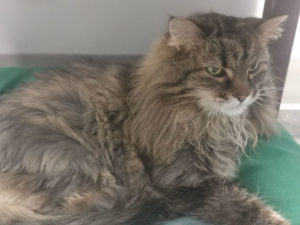Cats are not only predators, they are also prey for larger carnivores like coyotes. A predator will target a weak or injured prey animal so it is important that prey animals hide their pain, so they don’t become some else’s snack. Cats are no exception and are masters at hiding pain. As a veterinary technician, I have found clients often do not give pain medication that we send home because “he didn’t seem painful”.
how do I know if my cat is painful?
It is hard to assess pain in animals and young children. They can’t tell you how it hurts. There has been interest in developing methodology for computer assessment of pain in human children using facial expressions. Humans have expressive faces, with 42 facial muscles; there is a universal “pain face”, with lowered eyebrows, eyes squeezed together, nose wrinkled, raised upper lip and open mouth.
Like us, cats also have a “pain face” but it takes some practice to become attuned to it. The Feline Grimace Scale (FGS) was developed to give veterinary professionals an easy-to-use tool to assess whether a cat needs pain medication. With some practice and attention to your cat’s environment, you can tell if your cat is painful.
The FGS focuses on 5 facial features:
- position of the ears
- shape of the eyes
- shape of the muzzle
- attitude of the whiskers
- position of the head
Each feature is assigned a score of 0, 1 or 2.
“0” = no pain
“1” = moderate appearance of pain
“2” = obvious appearance of pain
The highest pain score with this system is 10; a score of 4/10 indicates the need for pain medication.
The Kitty Pain Face
scoring The Ears
- Score = 0 Ears are up and facing forward
- Score = 1 Ears are not facing forward and further apart; they are a little “flat”
- Score = 2 Ears are flattened and rotated out, like the wings of an airplane
scoring the eyes
- Score =0 Eyes are open
- Score = 1 Eyes partially closed
- Score =2 Eyes are “squeezed shut”
scoring the muzzle
- Score = 0 Muzzle is relaxed and round in shape
- Score = 1 Muzzle is tense and starting to become flatter
- Score = 2 Muzzle is tense and elliptical in shape
scoring the whiskers
- score = 0 Whiskers are relaxed and curved downwards
- Score = 1 Whiskers are beginning to straighten, as the muzzle becomes tense
- Score = 3 Whiskers are straight or forward
scoring the head
- Score = 0 The head is up and above the line of the shoulders
- Score = 1 The head is in line with the shoulders
- Score = 2 The is below the line of the shoulder
Using the FGS
The FGS was developed for veterinary staff to monitor hospitalized patients. In the validation studies, cats were observed undisturbed for 30 seconds. This could be a challenge in the home, where the cat is not in a kennel and can move around.
Pain causes anxiety and stress. The expressions making up the cat’s “pain face” overlap with the body language of stress. How can you eliminate environmental stress when scoring your cat for pain?
getting a valid score for your cat
Don’t have 30 seconds?
If you’re having trouble watching your cat for 30 seconds, try scoring your cat, then score him again in 15-20 minutes and see if you get the same results as before.
Pain or environmental stress?
Reduce the effect of the environment on your cat. Don’t have someone hold him or rub his head. Try to observe him when there is not a lot of activity in the house – try guiding him to a quiet room and let him settle down before you try to score him. Don’t interact with him – he may respond by hiding his pain.
If your cat is grooming, eating, or vocalizing, wait until she is finished before assessing her. If sleeping, wait until she is awake.
practice telling if a cat is painful
Using the FGS can be challenging but it can help you decide sometimes if your cat needs veterinary treatment. Practice observing cats that are painful or not painful to give yourself a mental map of the cat’s face and demeanor.
- Go to felinegrimacescale.com, and download the FGS manual.
- Using the FGS manual, practice your skills with the series of 11 cat photos on the website.
- Compare your results with those of the researchers.
Other indications that your cat is painful
- she is hiding or you find her in a place she usually does not frequent
- she is more subdued than usual
- there is a decrease in appetite and activity
Want to keep up with the world of cats? Subscribe to The Feline Purrspective!



Marion Baker says:
Good article .. thank you ?
Fondly
Marion